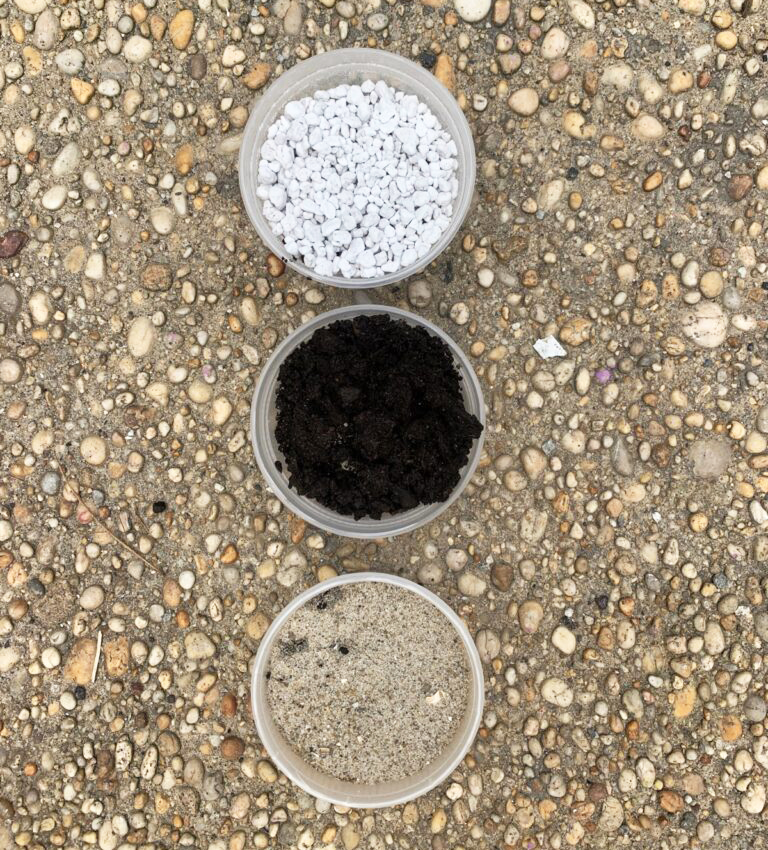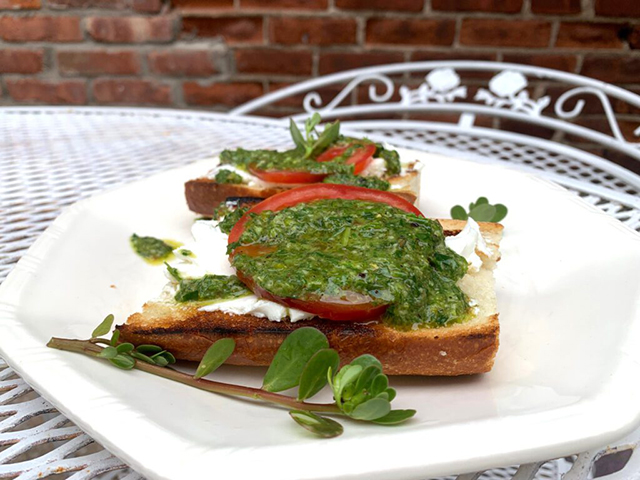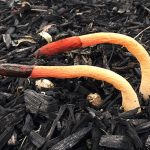by Paula D.
on August 24, 2022 11:54 am in Gifts
This August heat! Watering our gardens at this point in the season is crucial. We’ve spent months caring for our veggies and now it’s make or break.
Inconsistent watering will affect your tomatoes. I’m having a problem with my heirloom tomatoes… I have blossom-end rot. This is a common problem that often affects larger varieties simply because they take longer to mature. But blossom-end rot can also affect cherry, grape, and other smaller varieties.

Blossom-End Rot
Blossom-end rot is a physiological condition (not fungal) caused by environmental stressors. Most often though, its lack of/or inconsistent watering or a calcium deficiency in the soil. Now, these above-mentioned issues go hand and hand. If you’ve composted in the spring, chances are there is enough calcium in your soil. The problem is that the plant can not access enough of this mineral because it is not being watered properly. The plant needs ample water to absorb the calcium. Temperature and salt also play a factor… and we have salt in our soil.
The condition starts with a dark “scab” on the bottom of the tomato. The blemish will continue to grow into a dark brown-like bruise.
It’s not too late to correct this nutrient problem. Here’s the midsummer fix:
- Remove all affected tomatoes so the plant is not wasting energy, water and calcium on these damaged fruits. It is safe to remove the blemish and eat the healthy part of the tomato.
- Buy a calcium supplement and use as directed. Egg shells will not work at this stage as they need time to decompose.
- Water twice a day in extreme heat. And when I say water, I mean saturate the soil. Sprinkling water on your garden isn’t enough. When you think about it, how much of that soil below is actually wet, maybe only an inch? The soil needs to be moist at least a foot deep.
- I wrote about mulching a few weeks back. Mulch around your tomato plants. Mulching prevents evaporation and will retain 80% of the soil moisture.

Follow this guide and the problem will resolve in about two weeks. There is still plenty of tomato time! Good luck.
NOTE: I came across this interesting bit about a tomato variety named “The Mortgage Lifter.” The cultivar was created in 1922 by Willam Estler of Barboursville, West Virginia (registered in 1932). The taste is a mild, sweet flavor. It’s pinkish red in color. The tomato is large and can grow to be two pounds! The Mortgage Lifter was the most popular of a group known as the Great Depression-era tomato breeds. They were developed for their saleability. It is said this allowed small plant nurseries and farmers to recover from debt.
For more on gardening, follow me for the day-to-day in the field on Instagram –@theglorifiedtomato.

I’ve always admired prickly pear cactus for its distinctive paddle spikes, bright red buds, and showy yellow flowers. There are 181 different species. Opuntia is a perennial shrub with waxy skin. The cactus thrives in sandy soil and dry conditions. It grows wild in arid areas in the south and southwest. Opuntia is indigenous to the Americas. Pear cactus is a domesticated crop plant grown and harvested throughout the world.
Right now is the plant’s growing season and when you see “baby paddles” forming. This is the ideal time to propagate. I’ve never grown prickly pear myself, so I was excited to give it a try. My friend Kristi, a fellow garden member (@beach91communitygarden), has a large prickly pear patch that she cares for. She offered me some paddles for my propagation project.

The process is simple:
- Using gloves, gently pull or cut a clipping off the main paddle. Look for the joints where each paddle connects. Repeat to gather as many as you need.
- Dry the paddles for about 5 days so the wound calluses over. Why is this important? All cacti need very little water and this will ensure the clipping does not rot when planted. The wound will look brown when it’s ready. You don’t have to wait for roots to sprout before planting.
- Soil is important. Use a cactus mix which you can buy at the garden center or this low-cost soil recipe: 2.5 cups of soil, 1 cup of coarse sand (we have plenty of that), and 1 cup of perlite.
- Plant! Choose a container with drainage holes. Fill the pot with ⅔ soil mix. Place the prickly pear(s) upright in the pot and use a spoon to add more soil mix on top. Pat the soil until the pad is sturdy in place.
- Water the pot thoroughly. After one week give the pad a tug. If it feels secure with resistance, your plant has rooted! The rooting process may take up to two weeks. A misconception is to water cacti scarcely. The proper watering regiment is this: saturate the container (must have drainage) once every 2-3 weeks. Leave the cactus to dry out completely before the next watering.
Prickly Pear can live indoors or outdoors in pots or in the ground. Take your pots inside in the late fall to enjoy these plants year-round. Integrate into your home decor for a fun southwestern vibe! Prickly Pear needs a south-facing window with plenty of sun.
As mentioned above, prickly pear is an agricultural crop. Yup, they’re edible! Often cocktails are made with sweet fruit. I’ve seen prickly pear in Key Food by the refrigerated produce. They can be eaten raw or cooked. I think it’s about time I try a recipe using this unique food, stay tuned for that…

Follow Paula in the field on Instagram @theglorifiedtomato.
It’s like dancing in the ocean. Movements in synchronicity with the water – in part controlled by your body and part guided by the rhythm of the ocean. The music blends with the sounds of the waves, birds and planes. If this connection to nature intrigues you, join like-minded swimmers in our community tomorrow, Saturday, July 23rd on Beach 94th Street for the first of five synchro swimming workshops.
Artist Ritta Ikonen is the organizer who conceptualized this project. She shares the details:
Synchronized Sea Swimming Club is a series of five free performance workshops where anyone can take part in performances and routines that are in sync with Rockaway’s most formidable neighbor, the Atlantic Ocean.
Recognized and celebrated as the all-encompassing force across cultures and times, the sea will act as the main protagonist throughout the project, connecting humans with their surroundings and their respective cultural expressions.
Success is measured by finding harmony with the Atlantic Ocean. Anyone, regardless of background, status, or orientation can join in for free, for one or all of the workshops.
Immersing yourself in seawater, your whole body understands things your eyes never will. One may experience relief by being held entirely by a living mass, an ocean larger and more primal than what we frequently perceive.
The Synchronized Sea Swimming project will begin with a meeting and a presentation with a synchronized swimming coach Kara Gadeker, who will introduce the participants to the basics of the sport and inspire commitment ideally to all workshops. Gadeker, swam competitive synchro in VA for 16 years and has a PhD in marine science. Our other teacher is the land and the sea. Participants will practice various choreography in the water over the five sessions to gain more profound ways of listening and interacting with our surroundings.
Photographers Susannah Ray (@susannahrayphotography) on land and Jena Cumbo (@jenacumbo) in the water will be documenting this project.
What I find most interesting about this interactive swim experience is, unlike the Olympic sport of synchronized swimming, Ritta’s intention is non-anthropocentric. The workshop will focus on our connection as humans to nature. This theme is overarching in all of Ritta Ikonen’s artistic pursuits.
Seachanges, which has become very popular in Rockaway, is a winter artistic swimming practice inspired by Ikonen’s native Finland, where cold water plunges are the norm. Riitta’s goal during the pandemic was to build community during an unprecedented human experience, while connecting us to our natural world. When Riita is not swimming in the sea, she is collaborating on projects such as her work with artist Karoline Hjorth. Eyes As Big As Plates explores the personifications of nature and folkloric traditions in Nordic countries. The duo’s work consists of one hundred plus stunning portraits where humans are integrated into natural environments throughout 14 countries thus far.
Join the synchronicity! The first swim is tomorrow, Saturday, July 23 from 1-4pm. Additional sessions:
July 30 & 31, 1-3pm
August 6, 1-3pm
August 27, 1-3pm
Swim playlist by Mister Ian Wright (@misterianw) from Do!!You!!! Radio
This project is made possible (in part) by the Queens Council on the Arts with public funds from the New York City Department of Cultural Affairs in partnership with the City Council.

 Purslane
Purslane
I know a great deal about foraging at this point in my gardening “career.” But there’s always more to discover. A few weeks back, I learned of a new edible from my friend Melissa Draugsvold. We were at the Beach 91st Community Garden watering our adjacent plots. She pointed out the purslane that popped up between her lettuce crop.
Purslane (also known as little hogweed, pigweed, pusley) is an annual in our garden zone 7. This succulent can grow in sandy soil and resists drought. You’ll see it everywhere if you look closely – even sprouting out of cracks in the sidewalk. One plant will produce an exorbitant amount of seeds and so, it is here to stay. Purslane has been cultivated since Roman times as a rich food source. But today, due to its vigor, purslane is dumped into the sad category of weeds. But the trend may be changing. My friend Kristi said she saw purslane at a farmers market in Brooklyn selling for 7 bucks a bundle! I guess these folks don’t realize they should just look down to find it for free.
I asked Melissa if I could harvest some of her purslane. Yes, of course, I could! Melissa explained that all parts of purslane are edible – stems, succulent leaves, and yellow flowers. I gave it a taste right there in the garden. It’s tart, salty and juicy. The texture is crunchy!
I went home with my crop and read about this new food find. Purslane is an herb best used fresh but can also be cooked like spinach. Purslane is 93% water. It contains rich amounts of vitamins E and C. It has seven times more beta carotene than carrots! It contains minerals and is a robust source of omega-3 and is low calorie.
Use it like a leafy green. It works well in salads, in lieu of lettuce on a sandwich, atop a taco or layered dip, in smoothies, etc.
An interesting point on harvesting: The plant converts malic acid into sugar as the day progresses. Malic acid is responsible for tartness. If you prefer a more mild flavor, harvest purslane in the early evening. If you like bitterness (bitter is not bad), harvest in the morning. With any foraged food, be mindful of where you’re gathering. Be aware of pesticides, exhaust, dogs, etc.
I decided to make a purslane herb spread to use on Italian bread with goat cheese and ripe tomatoes. I added other herbs from my garden for a robust, rich flavor.

Purslane Herb Spread Over Goat Cheese and Tomatoes
Ingredients for the dressing:
1 1/2 cup extra virgin olive oil
1/2 squeezed lemon
1/2 cup purslane, more for garnish
3 sprigs fresh oregano
4 sprigs fresh parsley
10-15 basil leaves
1-2 ounces of chives
1 clove garlic
Fresh ground pepper, red pepper flakes, and salt to taste
Additional:
Sliced ripe tomatoes
Goat cheese
Italian bread
Directions: Rinse the foraged purslane. Combine all the herbs and the garlic in a food processor with the oil, spices, and lemon. Pulse for 30 seconds. Let the mixture sit for at least one hour before using.
Also, try the purslane herb spread on meats or fish for the grill. It can also be used like pesto on pasta. Enjoy!































